Montenegro: ‘Black Mountain’ is Green Paradise
A small but brilliant jewel in the Balkans along the Adriatic Sea, Montenegro has it all in topography for tourism, including a long coastline, the planet’s southernmost fjord (Boka Bay), Europe’s cleanest river (Tara), the largest lake in the Balkans (Skadar), five national parks, endless mountains and one of the last rainforests on the continent (Biogradska Gora). No wonder Montenegro became the first ecological state in the world in 1991.
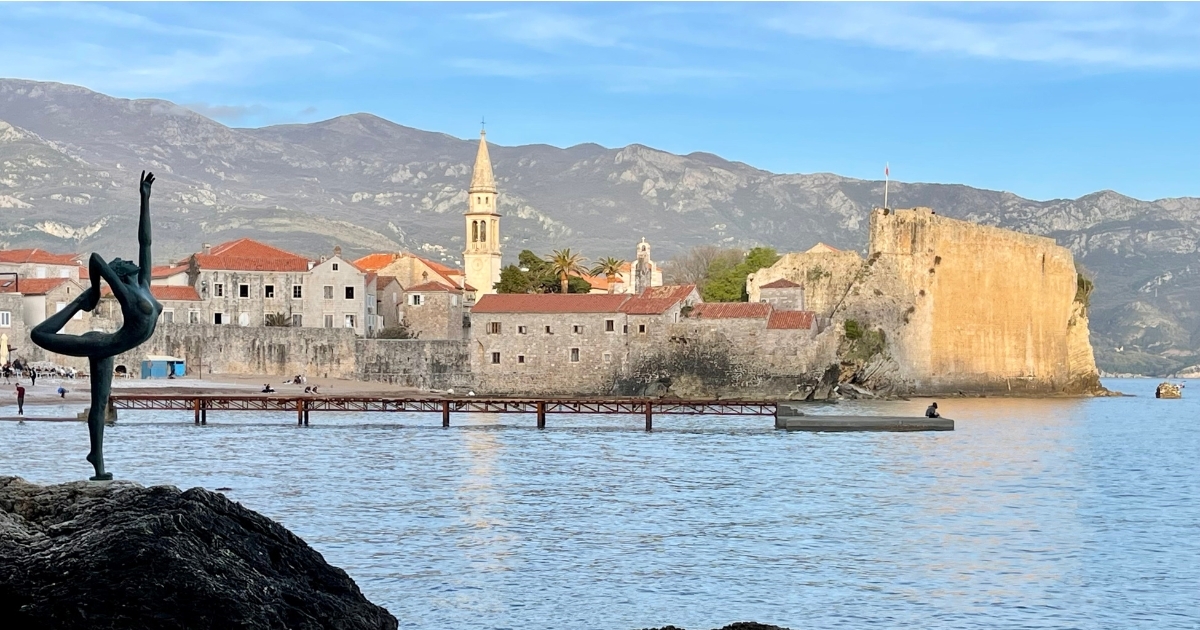
Called Crna Gora in Montenegrin, Montenegro is its international name, which is thought to have been given by Spanish sailors passing through the Adriatic Sea in the 15th century. Meaning “Black Mountain,” the country is true to its name in peaks but more green in colour overall with lush vegetation. Tourists can enjoy its beautiful natural environment – from water sports in the south to hiking, rafting and skiing in the north – plus great culture, food, wine and hospitality.
In the heart of the Balkans, Montenegro borders Serbia to the north, Kosovo and Albania to the east, and Bosnia and Herzegovina and Croatia to the west. It is a member of the United Nations (2006) and NATO (2017) but not yet the European Union (accession has progressed slowly since 2012). Nevertheless, Montenegro’s far south has strong Italian influence due to nearly 400 years of Venetian rule and proximity to Italy. Much of the rest of the country has Turkish influence due to Ottoman occupation for four centuries as well.
Montenegro has a phrase sve može meaning “everything is possible,” which is useful in a country whose main industry is tourism. Safety and security are also assets and the country is convenient for international visitors with its use of the Euro and English as a tourism language.
The best time to go to the “Black Mountain” for sun is May, June, September and October. July and August are the most crowded and hottest (40C+) months. For snow, January to March is best. But with roughly 240 sunny days a year, Montenegro is welcoming almost any time.
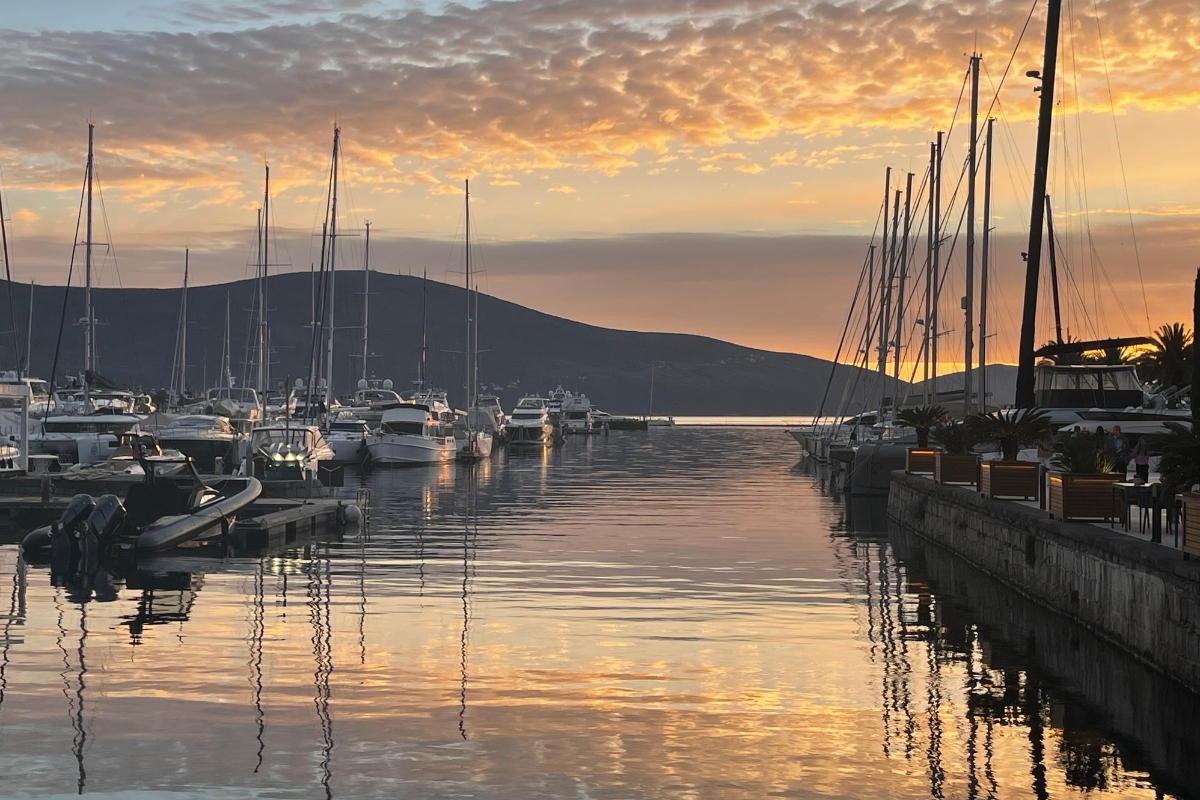
Porto Montenegro
This utopian village and marina next to the coastal town Tivat on Boka Bay was built on a former Austro-Hungarian naval arsenal. It boasts a luxury hotel (Regent but soon also SIRO Boka Place), excellent international restaurants, high-end boutiques, outdoor activities from padel to archery, an open-air nightclub and gym, a recording studio, and new entertainment and exhibition centre. The latter in a former shipyard building offers diverse events and activities from fashion shows to music workshops.
Porto Montenegro also has a Naval Heritage Museum in a restored Austro-Hungarian sawmill, featuring more than 300 artefacts from former Yugoslavia, including two submarines. The larger one (P-821) can be explored inside – a rare tourist option.
Porto Montenegro has a perfect bay with calm conditions and no cruise ships. Its award-winning marina, designed by captains, has 460 berths, including 150 for superyachts. Eventually, the number of berths will double to 850. Only about half of the port’s land has been developed to date so considerably more restaurants, boutiques and amenities are in the pipeline as well.
While the Monte Carlo of the Balkans visually, locals claim Porto Montenegro doesn’t want to be otherwise. They take pride in the village’s “down-to-earth luxury” and integration with the local community of Tivat. In turn, this adjacent town offers several sandy beaches, including the upscale Waikiki Beach and Lustica Bay Marina Beach.
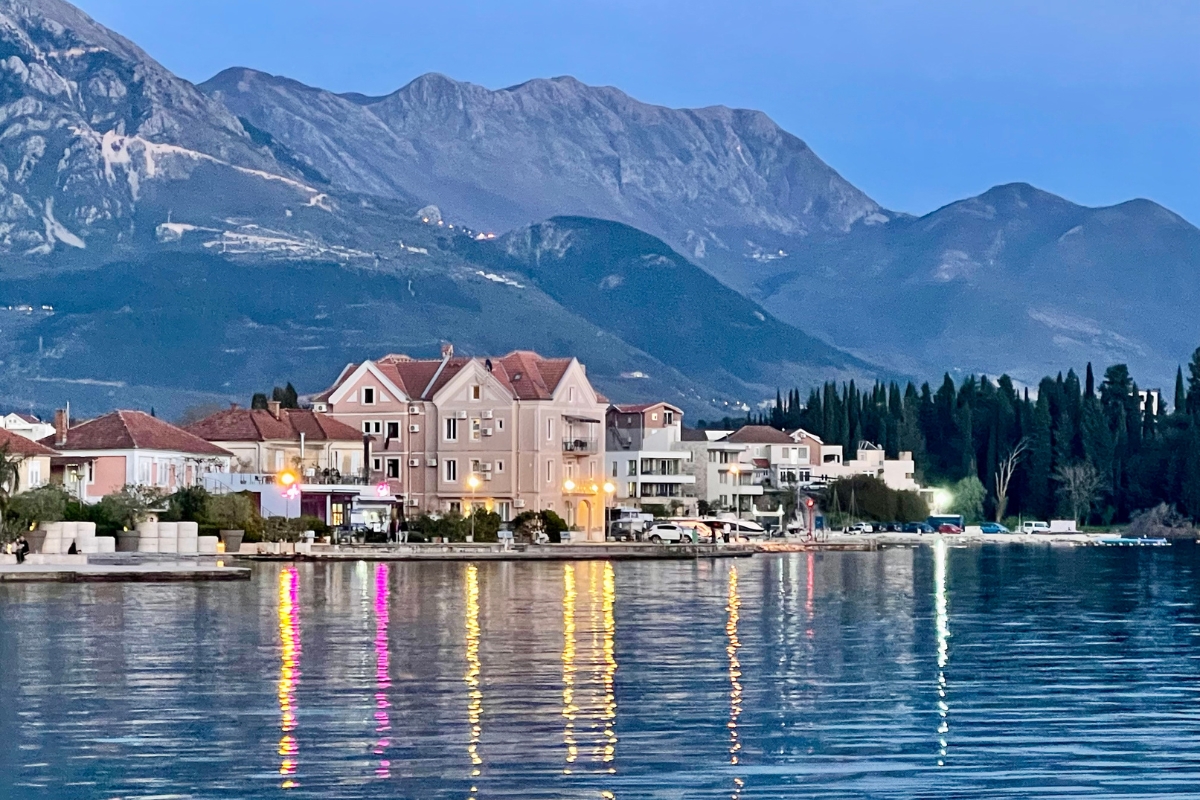
In the summer, an 11-minute cable car ride starting near Tivat Airport up to Mount Lovćen, known as the Montenegrin Olympus, offers spectacular views of Boka Bay and Kotor Old Town. At the top, a few kilometres from the cable car station, is the Mausoleum of Njegoš interring Prince Petar II Petrović-Njegoš, a famous poet, in a chapel with 200,000 gold-plated mosaic tiles.
Tivat international airport, the only option besides Podgorica to fly to Montenegro, has year-round flights from Belgrade and in the summer, from a variety of cities. (The small airport does not have night lights so winter flights are limited.) Water taxis can be taken from the airport to Boka Bay destinations. Porto Montenegro is a wonderful base from which to explore the bay and central towns but venture elsewhere for the real Montenegro.
Boka Bay
Boka Bay, also known as the Bay of Kotor, is the largest in southern Europe with a shoreline of about 107 kilometres. Besides Porto Montenegro, it is dotted with quaint villages like Perast and the charming towns of Kotor and Herceg Novi. Each location typically has its own wines, rakiya (eau de vie), honey, cheese, olive oil, cured meats and more, which can be purchased in a weekly farmer’s market.
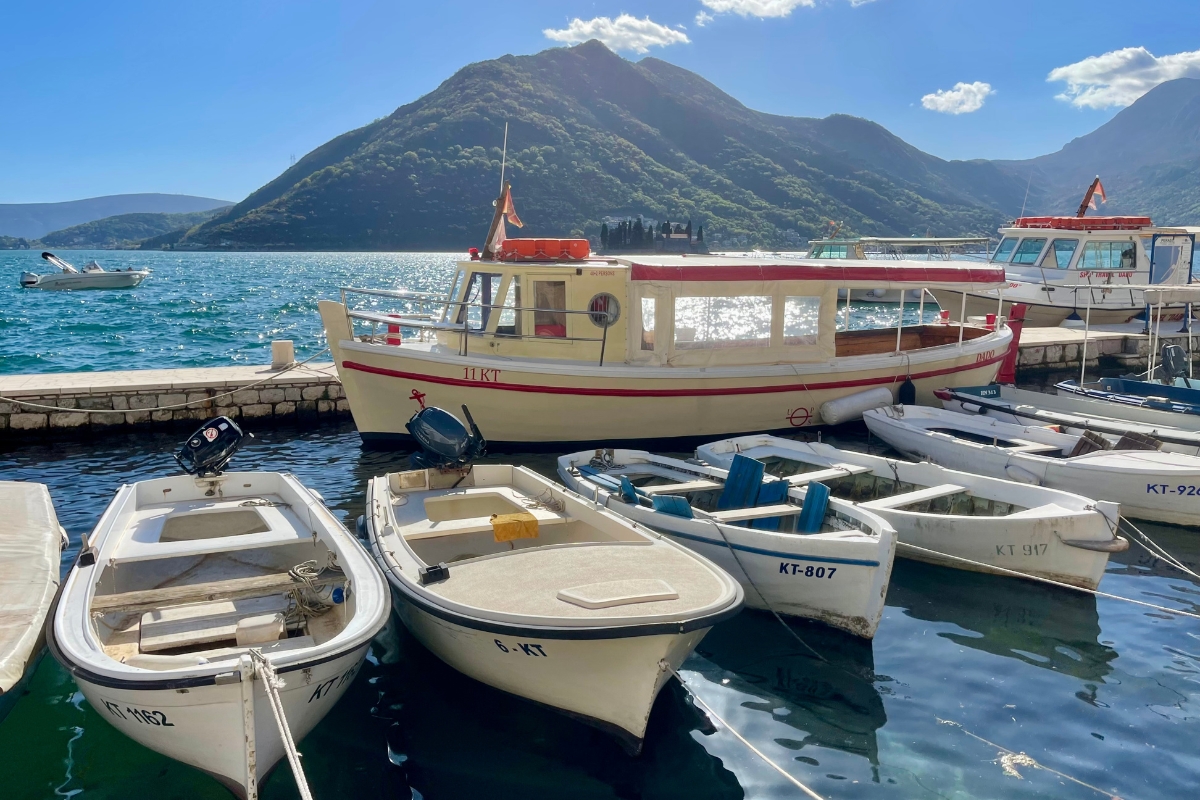
Kotor Old Town is an UNESCO World Heritage Site due to its well-preserved medieval fortress, buildings and defensive wall. The stone wall encircles the town in 4.5 kilometres. Visitors can climb nearly 1,400 steps up to San Giovanni Castle for breathtaking views of the bay.
Inside the old town are narrow streets filled with cats and a mix of Baroque, Venetian and Austrian architecture. Notable sights are a 1602 clock tower, three town gates, nine palaces, St. Tryphon cathedral of 1166 and St. Lucas church of 1195.
The nearby village of Perast is a charming, peaceful respite with only about 300 residents. It contains Baroque buildings, including 16 palaces and 17 churches, most notably Our Lady of the Rock and St. Nikolau. The latter has the highest tower on Boka Bay, which can be climbed for lovely views.
Our Lady of the Rock church was built after local sailors discovered a painting of Madonna and child on a rock in the sea in 1452. Viewed as divine direction, locals created an islet in ship shape over 200 years with 106 obsolete sunken boats and rocks to build the church on top of it. Inside the church are artistic treasures, notably 68 oil paintings by Tripo Kokolja (1661-1713), the “Michaelangelo of Perast,” and an embroidery masterpiece including the artist’s own hair that took 25 years to complete (1803-28). An annual rock-throwing festival called Fašcinada celebrates the construction of the islet and church. Water taxis go there daily from Perast.
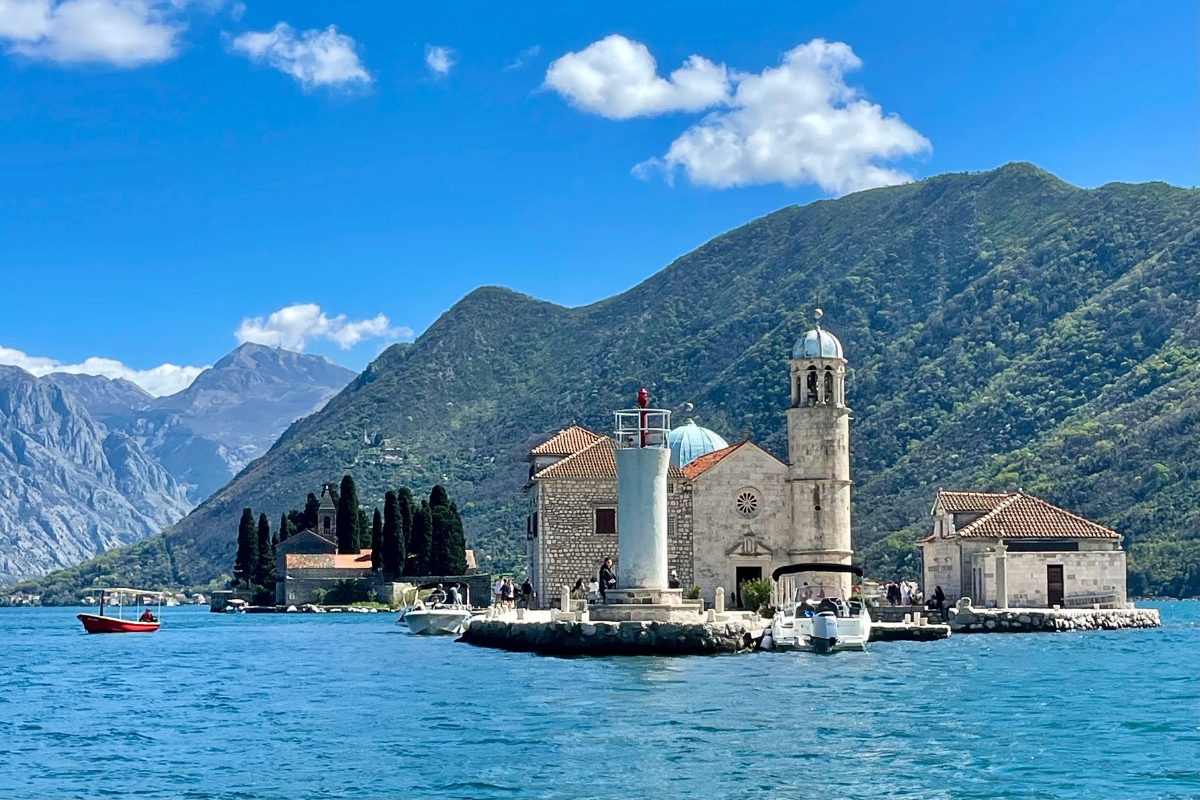
Herceg Novi on the other side of Boka Bay has an impressive old town, coastal winery called Savina, and Portonovi luxury resort and marina. The town is known for flowers, particularly yellow mimosa, which are celebrated in an annual festival. During the summer, an iridescent Blue Cave in Boka Bay is accessible by speedboat from Herceg Novi.
Coastline
Three cities dominate Montenegro’s southern coastline: Budva, Bar and Ulcinj. Fifty percent of all tourism goes to Budva because it has a “town of Illyria” more than 2,500 years old, many beaches along its riviera, plentiful water sports and booming summer nightlife. Bečići and Sveti Stefan arguably have the best beaches with long stretches of fine tan and reddish sand, respectively. A coastal mountain pathway from Mogren I and II beaches offers spectacular views.
Budva’s old walled town charms visitors with its narrow streets and buildings dating to ancient, Roman, medieval and new ages. Each cultural monument has a plaque with a QR code for convenient information. An Austro-Hungarian citadel, adorned and scented by purple-flowering Chinese Wisteria trees, offers self-guided tours and a terrace restaurant. Small Dukley Marina just outside of the old town has slips for a few yachts.
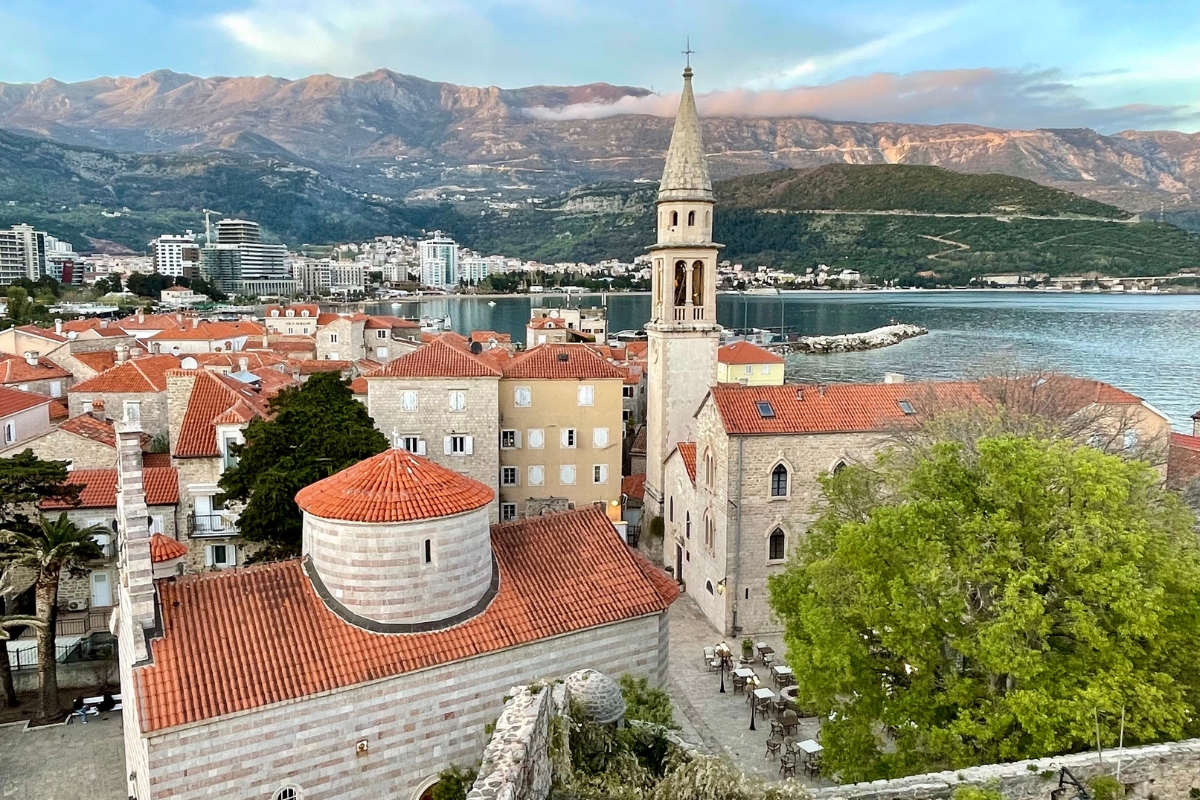
One kilometre from the old town shore is Sveti Nikola nature reserve, the largest island on the Montenegrin coast. Known locally as “Hawaii” due to rocky beaches, it has a tiny church and fallow deer. It can be reached by speedboat or sea kayak.
On the other side of Budva is the exclusive village peninsula of Sveti Stefan, built on a natural islet with a big rock that is connected to the mainland via a bridge. Since 2020, it has been closed due to a lawsuit between the islet lessee and Montenegrin government. Ordinarily, the peninsula is only accessible to guests of the exclusive Aman Sveti Stefan hotel, which owns Villa Miločer, a queen’s former summer residence, and private beaches. It’s been a getaway hideaway for celebrities for decades; think Orson Welles, Elizabeth Taylor, Marilyn Monroe, Sophia Loren, David Beckham and Novak Djokovic. Beaches at Sveti Stefan’s northern and southern ends are public and small boats can be hired from Budva to go past the luxury islet, ironically first settled by fishermen in the 15th century.
The city of Bar – derived from “anti-Bari” opposite of Bari, Italy – is the most populated on the Montenegrin coastline and includes old (upper) and new (lower) parts. The old town, an UNESCO World Heritage Site, is considered the largest and most important medieval archaeological site in the Balkans. Built on a cliff, it has buildings from the 10th to 19th centuries. A museum about Nikola I Petrovic Njegos, the first and last king of Montenegro, is in his former palace. The oldest tree in Europe lives in Bar: a 2,000-year old olive tree with a 10-metre circumference.
Similarly aged Ulcinj near Albania on the southeast coast is blessed with fine sandy beaches, including Velika Plaža (Long Beach), the longest beach on the Adriatic Sea (13K). It’s a paradise for kitesurfers and horseback riders. Ulcinj also has an important old town with traces of 25 centuries of civilization, including Illyrian remnants and an archaeological museum.
New and Old Capitals
The current capital of Montenegro, Podgorica (pronounced Pod-gor-reet-za), is home to a third of the country’s population. It means “under Gorica Hill” in reference to its geolocation. It was bombed more than 70 times during World War II so it is largely rebuilt. Today it is one of Europe’s greenest cities with several parks, five rivers, sustainable initiatives and outdoor activities from trout fishing to kayaking.
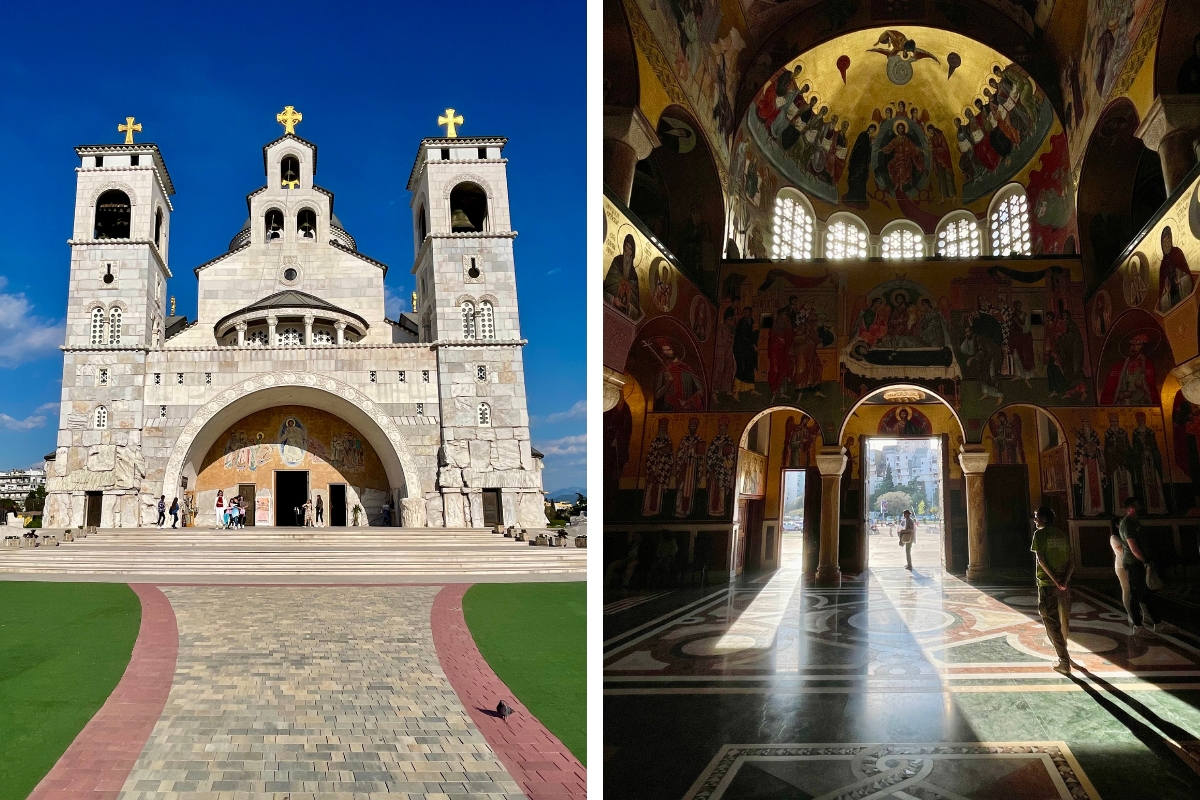
Gorica Hill Park is the “soul of the city” and green lung with a protected natural area, 3.3K in pathways, Adventure Park with zip lines and wild orchids. The area is also home to St. George’s Church, which is more than 1,000 years old, and a 1957 Fallen Partisans War Memorial, which contains the remains of 66 national heroes.
Podgorica is known as a city of bridges, including the stunning suspension Millenium Bridge and Romanesque Hadži-Paša’s Bridge over the Morača River. Pebbles from this river were supposedly used to create alleys during the Ottoman Empire in the surviving old town. Complementing these alleys are high stone walls, a 15th century mosque and an 18th century clock tower. Also in this area is Gallery Risto Stijović, which has a permanent collection of works by this late famous sculptor in his birth house.
Palace Complex Kruševac, with 13 monuments of historical rulers, as well as the restored City Hall and Communist-looking Square of Independence give further perspective on Podgorica’s history. (The drab square comes alive in the summer with pop-up shops and festivals. Nearby Bokekska street is always lively.) Four kilometres from Podgorica’s centre is an archaeological site of the 1st century town Doclea.
The Museum of Contemporary Art of Montenegro is housed in the former Petrović Castle, where the royal family used to live. Today, it features temporary exhibitions, often by international artists, as well as a hidden second floor office of Prince Nicolas, the great, great grandson of King Petrović. Surrounding the castle is a beautiful park and small, historic church.
Not to miss in Podgorica is the Cathedral of Christ’s Resurrection, which took 20 years (1993-2013) to complete and visibly so. Of Byzantine influence, this modern masterpiece includes 6,000 square metres of ornate paintings and nearly 2,000 square metres of exquisite mosaics. A sculpture of Nikola Tesla, who invented modern electricity, is outside of the cathedral.
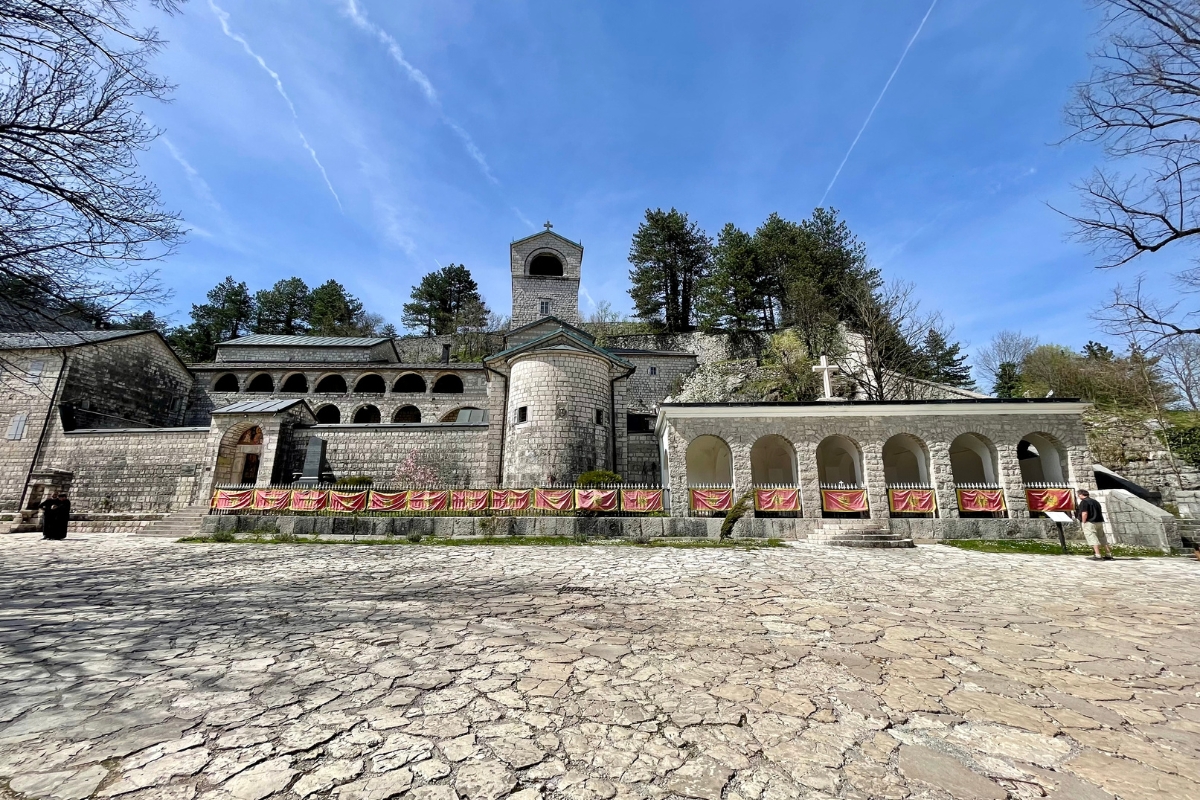
The old royal capital of Cetinje was so until 1954. It is home to many former embassies and royal palaces; six museums, including the National Museum of Montenegro complex; historical churches and street dogs. Don’t miss the Cetinje Monastery from the early 1700s, which stores relics of the hand of St. John the Baptist and pieces of the Holy Cross; Blue Palace residence of the Montenegrin president; and former French Embassy with colourful mosaic tiles. Also of interest are the historic Court Church, Vlaška Church with a fence made of Ottoman rifle barrels and Fairy of Lovćen sculpture in front of it; 15th century amphitheatre; and Mausoleum of Bishop Danilo atop Eagle Hill. The latter is accessed by a 20-minute walk and the view of Cetinje is worth it.
Surrounding Podgorica
Ostrog Monastery, carved into a vertical cliff face, is one of the largest Orthodox shrines in the world and rarest architecturally. It is considered a miracle partly built by nature, which is visited by people of all faiths. Note it is mobbed on religious observances, especially May 12, the day of St. Ostrog, when people pilgrimage there from all over the Balkans!
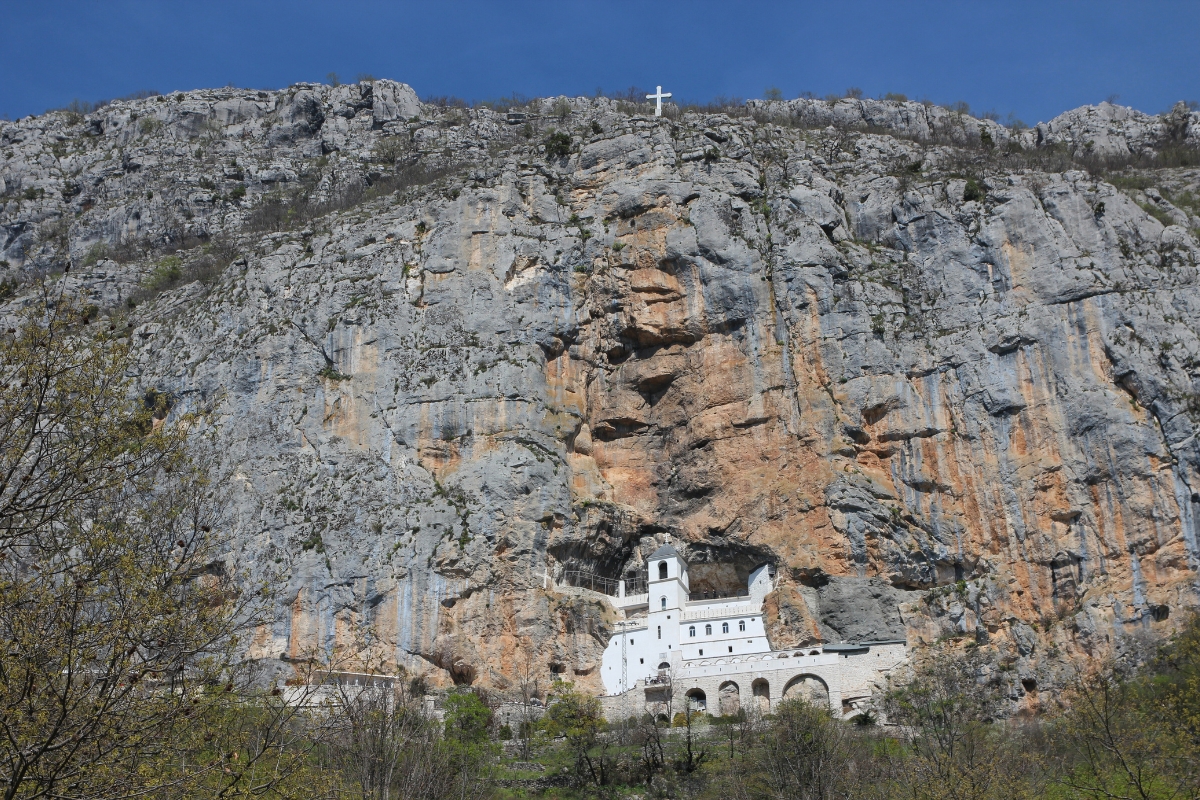
Skadar Lake National Park has the largest lake in the Balkans, 60 islets, 20 monasteries, 18 historic monuments and 250 bird species, including the rare curly pelican. It is often used for movie sets. Boat rides can be taken from the lake villages of Virpazar, Vranjina and Plavnica.
Most wineries in Montenegro are around Lake Skadar. Tours are available at Plantaze, a government-owned winery with more than 2,300 acres – one of Europe’s largest vineyards – and Lipovac, the largest private winery that makes wine in ancient Georgian clay pots in the ground and Italian terracotta amphoras. There are also plenty of boutique vintners like Garnet in the village Godinje that make good wines. The most common indigenous varietals are Vranaç (red) and Krstaç (white). Montenegrin wine goes well with its cuisine, which is a combination of Venetian, Ottoman, Austro- Hungarian and Balkan heritage.
Northern Peaks
Montenegro has four national parks north of Skadar Lake: Durmitor, Biogradska Gora, Lovćen and Prokletije. Durmitor is an UNESCO World Heritage Site that covers five municipalities over 39,000 hectares. It includes Tara River, which has water so pure it’s drinkable, and five glacial lakes or “mountain eyes,” the largest of which is stunning Crno (Black) Lake. Tara River created the second largest canyon in the world, making it fantastic for rafting and ziplining. Near the Djurdjevića Tara Bridge is Europe’s highest zip line. Combined with mountains, pine woods, flora and fauna, Durmitor is a nature lover’s paradise.
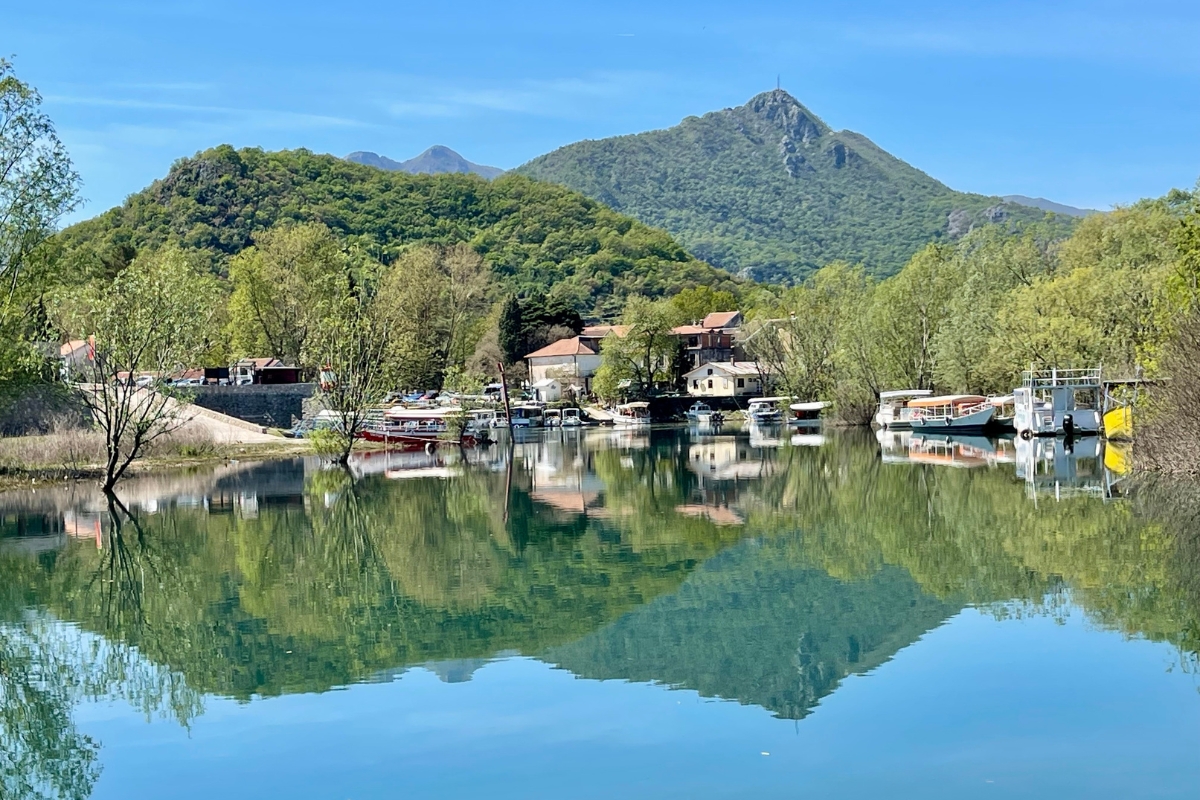
In the winter, Durmitor is the country’s primary ski destination, namely Žabljak, the highest city in the Balkans. Snow cover in the area lasts about 120 days per year. Skiing is also normally possible in Kolašin, a city in a dense pine forest less than an hour’s drive north of Podgorica, but in recent years, scarce snow has closed ski resorts there.
Biogradska Gora has 1,600 hectares of virgin woodland, six glacial lakes and lots of flora and fauna. It is listed on UNESCO’s World Network of Biosphere Reserves as a temperate rainforest.
Lovćen, named after its highest peak, is a rich biosphere that is home to more than 1,000 types of plants. Its forest trails dotted with katuns, old summer settlements used by cattle breeders, are ideal for hiking.
Prokletije has the most vertical peaks that form a natural border with Albania, hence, the area is called the Albanian Alps. It is known for free-roaming goats.
In addition to stunning landscapes, Montenegro has excellent infrastructure to support tourism from well-paved roads to first-rate accommodations.
WHAT TO SEE
International Fashion Festival, Porto Montenegro: 19-20 July 2025 – Hosted at the Regent Hotel and on an open-air runway, the festival includes numerous fashion shows by top designers and exclusive events.
Fašcinada, Perast: Each 22 July, local men throw rocks from their boats around Our Lady of the Rock islet and women greet them from the shore – a tradition for more than five centuries.
Boka Night, Boka Bay: Every third Saturday in August, towns around the bay have celebrations, fireworks and boat parades.
Mimosa Festival, Herceg Novi: This annual tribute to the yellow mimosa flower throughout February ushers in spring. It includes carnival processions, masquerade balls, a fish and wine festival, international flower exhibition, concerts and more.
Carnival in Budva and Kotor: Budva hosts a six-day carnival in late April-early May and Kotor a three-day carnival in late July-early August. Both feature parades with exquisite costumes, masked onlookers, late-night celebrations, and regional cuisine and wine.
Grape (Grožda) Festival, Virpazar: Each September, this village on Skadar Lake celebrates local grapes, wine, vineyards and winemakers with tastings, cultural events and entertainment.
WHERE TO STAY
Regent Hotel, Porto Montenegro: This award-winning, five-star hotel with a nautical theme gives a nod to the area’s Venetian past with stunning Murano glass artworks. Each luxury room of 13 categories resembles a ship cabin. It has Murano fine-dining restaurant, a café, bar, garden, indoor and outdoor pools, and spa (with optional private use).
Heritage Grand Hotel, Perast: In a restored 18th century palace, this five-star hotel overlooks the Bay of Kotor and offers a spa, indoor pool and three restaurants – all with terraces.
Vissi d’Arte, Budva: This boutique luxury hotel on the seaside is inspired by art and includes a restaurant, beach and access to Avala Spa & Wellness.
Aman Sveti Stefan: This exclusive luxury hotel includes Villa Miločer, a restaurant, spa, indoor pool, three pink sand beaches, an emerald lagoon and forested privacy. (Note this hotel is currently closed. Check its website for re-opening dates.)
Signum Hotel, Podgorica: New in 2022, this modern luxury hotel within walking distance of downtown has a rooftop restaurant, spa, gym and rooms with balconies, including huge suites.
Casa di Pino, Žabljak: In the heart of Durmitor National Park, this luxury eco-lodge offers eight spacious rooms and apartments, including a buffet breakfast, sauna and lounge bar with fireplace.
WHAT TO SAVOUR
Mayabay, Porto Montenegro: Mayabay, which is entered through the Regent Hotel but independent, features gourmet Japanese cuisine in an exotic, elegant atmosphere.
Conte, Perast: A seaside restaurant of the Conte Hotel, it features fresh seafood and stunning views of Boka Bay.
Restaurant Galion, Kotor: This elegant, seaside Montenegrin restaurant is focused on local seafood.
Punta Konoba, Budva: Upscale but cozy, this Montenegrin eatery in the old town features seafood and other local ingredients.
Konoba Lanterna, Podgorica: In the oldest building in old town (1630), this authentic Montenegrin restaurant specialises in grilled meats.
WHAT TO SIP
Crush Wine Station, Porto Montenegro: This bar features Montenegrin wines by the glass and a terrace overlooking the marina.
Vista, Budva: Atop a cliff overlooking old town and the bay, this open-air restaurant has the best view of Budva – ideal for a sunset glass and nibble.
Itaka Library Bar, Podgorica: In a former Ottoman residence, this indoor-outdoor bar by the Morača River has a romantic ambiance and live music.
Gradska, Cetijne: This Montenegrin-influenced restaurant has a large terrace adjacent to the former Bulgarian embassy (now Gradska Hotel).
Goddo, Budva & Podgorica: This gelateria chain makes homemade gelato at its finest and serves it with a waffle cookie dipped in liquid chocolate.
WHERE TO SHOP
Murano Art Gallery, Porto Montenegro: It sells exquisite Murano glassworks of all sizes from jewellery to large wall pieces. It also sells gemstone jewellery by Italian designer Andrea Marazzini.
Namfleg, Kotor: In the 15th-century Jewellery & Watches Museum in old town, this shop features handmade cloisonne jewellery and watches as well as "hot enamel" workshops.
By the Sea, Budva: This family shop in the old town sells handmade souvenirs and gifts from Montenegro.
Lovac Organic Extra Virgin Olive Oil, Ulcinj: This generational family farm grows organic olives and makes its own extra virgin oil.
House of Wine, Cetinje: Located in the Njegos Park, this is a place to taste and buy Montenegrin wines amidst sommeliers.
Nomad Life Home, Podgorica: This gift shop sells handmade home décor items from local and international artisans, who also conduct workshops there.
** All images by the author Angela Dansby
